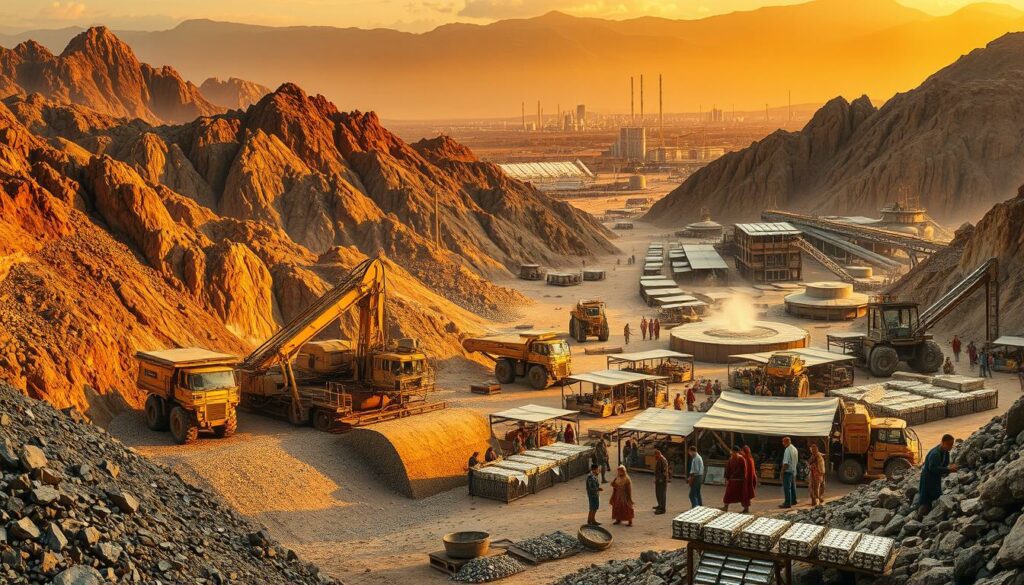Exclusive Deals & Trending Items
Did you know how important platinum is to cars? It’s key in making cars less harmful to the environment. It’s used in parts like catalytic converters, spark plugs, and sensors. This helps cars run better and use less fuel.
The car world is always changing, and so is the need for platinum. This makes it a great choice for investors looking to add precious metals to their mix. Knowing how platinum helps cars can help you make smarter investment choices.
Key Takeaways
- The automotive industry relies heavily on platinum for catalytic converters and other vehicle components.
- Platinum’s use in vehicles contributes to reduced emissions and improved performance.
- The demand for platinum is expected to remain strong, driven by the automotive industry’s needs.
- Investing in platinum can be a strategic move for diversifying your investment portfolio.
- Understanding platinum’s role in the automotive industry can inform your investment decisions.
The Precious Metal Platinum: An Overview
Platinum is a precious metal with special properties. It’s known for being dense and resistant to corrosion. It also has a high melting point, making it perfect for industrial uses, especially in catalytic converters.
Physical and Chemical Properties of Platinum
Platinum stands out because of its unique physical and chemical traits. It’s strong, durable, and doesn’t corrode easily. Let’s look at some of its key features.
Durability and Resistance Characteristics
Platinum is highly durable and doesn’t corrode, with a melting point of about 1,768°C. This makes it great for high-temperature jobs. Its toughness means it can handle tough conditions without breaking down, making it very valuable in cars.
Catalytic Properties Important for Automotive Use
The catalytic properties of platinum are key for its use in car converters. It helps turn harmful emissions into less harmful ones. This is important for the environment and for car makers to follow rules.
Some main benefits of platinum include:
- High melting point, ideal for high-temperature applications
- Corrosion resistance, ensuring durability and longevity
- Catalytic properties, essential for reducing vehicle emissions
When looking into investing in platinum, knowing its special traits and benefits to cars is key. With its rarity and high demand, platinum is a valuable and sought-after metal.


Platinum in the Global Economy
Platinum is key in cars and industry. It’s not just a precious metal; it drives the economy and offers investment chances. The global platinum market is shaped by supply and demand, politics, and the economy.


Major Platinum Producing Countries
Platinum is mainly made in a few countries, with South Africa leading. Knowing the global platinum supply chain is important.
South Africa’s Dominance in Platinum Production
South Africa makes most of the world’s platinum. The Bushveld Complex is famous for its platinum deposits. But, production can drop due to power cuts by Eskom, lasting up to 100 days. This can cut mining by 15%.
As an investor, knowing these issues is key to understanding the platinum market.
Other Key Global Producers
Other big platinum makers are Zimbabwe, Russia, and Canada. They add to the global supply, but not as much as South Africa. For example, Zimbabwe’s platinum production has grown, making it a big player.
Platinum’s price changes with supply and demand. Watch for news from these countries to know how it might affect your investments.
The demand for platinum will change with new tech and industry needs. Keeping up with these trends is vital for smart investments in platinum.
Understanding Platinum’s Unique Value Proposition
Platinum stands out among other precious metals, offering a special investment chance. Knowing its unique traits is key for smart choices.
Comparing Platinum with Gold, Silver, and Palladium
Platinum is often matched with gold, silver, and palladium for investment interest. Yet, platinum’s industrial uses make it different. It’s mainly used in cars for pollution control, making up over 75% of demand.
Here’s a look at how platinum compares with other metals:
| Metal | Primary Uses | Investment Demand |
|---|---|---|
| Platinum | Automotive, Jewelry | High industrial demand |
| Gold | Jewelry, Electronics | High investment demand |
| Silver | Electronics, Solar Panels | Moderate investment demand |
| Palladium | Automotive, Electronics | High industrial demand |
Factors Affecting Platinum Prices
Several things affect platinum’s price. Knowing these can help you predict market changes.
Industrial Demand Fluctuations
Industrial demand is a big factor in platinum prices. Changes in the car industry can change platinum’s price.
Geopolitical Influences on Supply
Politics in big platinum-producing countries like South Africa can change global supply. This affects platinum’s price.
Understanding these factors helps you make better choices in the platinum market.
The Automotive Industry’s Dependence on Platinum
The car industry relies heavily on platinum for good reasons. It’s because platinum has special properties that make it useful. For example, it’s key in making autocatalysts, which help cut down on emissions.
Platinum is also great because it can handle high heat and corrosive stuff. This makes it perfect for the tough conditions in car exhaust systems.
Catalytic Converters: Platinum’s Primary Automotive Application
Platinum is vital for making catalytic converters. These devices help clean up the bad stuff that cars spit out. They use platinum to turn harmful pollutants into safer stuff, helping the environment.
Platinum’s role here is huge. It helps cut down on bad emissions, which is good for the air and the planet.
How Catalytic Converters Work
Catalytic converters use platinum to start chemical reactions. These reactions change bad pollutants into safer stuff. Here’s how:
- They turn carbon monoxide into carbon dioxide
- They break down nitrogen oxides into nitrogen and oxygen
- They turn unburned hydrocarbons into carbon dioxide and water
These reactions happen inside the converter, which is in the car’s exhaust system. They’re key for meeting emissions rules.
Platinum Loading Requirements by Vehicle Type
The amount of platinum needed changes based on the car and its emissions rules. For example:
| Vehicle Type | Platinum Loading Requirement |
|---|---|
| Diesel Vehicles | Higher due to stricter emissions controls |
| Gasoline Vehicles | Lower compared to diesel vehicles |
Platinum is crucial in the car industry, especially for making catalytic converters. Its ability to reduce harmful emissions makes it essential. This is why platinum is a key part in making cars, especially for meeting tough emissions rules.
Platinum’s Critical Role in Modern Vehicle Manufacturing
The car industry depends a lot on platinum. Its special qualities make it key for many car parts, especially in catalytic converters.
Diesel vs. Gasoline Vehicles: Platinum Requirements
Diesel cars need more platinum than gasoline cars. This is because more diesel cars on the road means more platinum is needed. Gasoline cars, however, use less platinum. Knowing this helps predict how much platinum the car industry will need.
Luxury Automotive Brands and Platinum Usage
Luxury car brands use platinum because it lasts long and doesn’t rust. This makes their cars perform better and adds to their luxury feel.
Premium Vehicle Components Using Platinum
Platinum is in many high-end car parts, like catalytic converters and fuel cells. It’s great for these parts because it doesn’t melt easily and wears out slowly.
Indian Luxury Car Market Growth and Platinum Demand
The luxury car market in India is growing fast. This means more people want high-end cars. As a result, platinum demand is going up, which is good for the platinum market.
If you’re watching the market or investing, keep an eye on these trends. The luxury car market and platinum’s use in cars look promising for the future.
The Evolution of Platinum Demand in Automotive Technology
The use of platinum in cars is changing. This is due to new car-making methods and stricter emissions rules. Knowing about platinum’s past and future is key for those who invest in it and make cars.
Historical Trends in Automotive Platinum Consumption
Platinum’s use in cars has mainly been for catalytic converters. These converters cut down on harmful emissions. The amount of platinum used has changed over time. This is because of how many cars are made, emission rules, and the types of engines used.
- Stricter emission norms have led to increased platinum loading in catalytic converters.
- Diesel vehicles, which typically require more platinum than gasoline vehicles, have influenced overall demand.
Technological Innovations Affecting Platinum Usage
New tech is changing how platinum is used in cars. Better catalytic converters and cars that run on different fuels are leading the way.
“The development of more efficient catalytic converters has enabled the automotive industry to reduce platinum loading without compromising on emission standards.”
Thrifting and Substitution Challenges
Car makers are trying to use less platinum and find cheaper alternatives. They want to keep costs down while still meeting emissions rules.
Key strategies include:
- Improving catalyst technology to use less platinum.
- Substituting platinum with palladium or other precious metals where possible.
Recycling Impact on Primary Demand
Recycling is important for platinum demand. It takes 2-5 years for recycled platinum to reach the market. So, today’s high prices won’t boost recycling right away.
Investment Opportunities in Platinum
The automotive industry is changing fast. This makes investing in platinum a great chance to diversify. Platinum is key for making catalytic converters, which help cut down on car emissions.
There are many ways to invest in platinum. Buying physical platinum is one of the most straightforward. You can get coins, bars, or bullion. These are real assets you can hold or store.
Physical Platinum: Coins, Bars, and Bullion
Platinum comes in coins, bars, and bullion. Coins, like the American Platinum Eagle, are made by governments and are known worldwide for their quality. Bars and bullion offer more flexibility in size and weight.
When you invest in physical platinum, think about where you’ll store it. Choose secure vaults or safe deposit boxes at trusted banks. Remember to include the cost of storage and insurance in your investment plan.
Purity Standards and Certification
It’s important to check the purity and authenticity of platinum. Good mints and refineries give their products a seal of approval. Look for hallmarks or stamps that show the platinum’s purity, usually .999 or .9995 fine.
Experts say platinum is a great investment because of its unique qualities and role in the car industry. Always do your homework and think about your financial goals before investing in platinum.
“The value of platinum is not just in its rarity, but in its versatility and the critical role it plays in various industries.”
Learning about the different ways to invest in platinum helps you make smart choices. It’s a good idea to include platinum in your investment mix.
The Indian Platinum Investment Landscape
Platinum investment in India is growing fast. This is because of the country’s economic growth and changing tastes. People are now more interested in platinum, especially for jewelry.
Gold used to be the top choice in India, but platinum is making its mark. Its rarity, strength, and sleek look are drawing in younger buyers.
Platinum Jewelry Market in India
The market for platinum jewelry in India is booming. This is thanks to more people learning about and loving platinum.
Cultural Significance and Changing Consumer Preferences
Platinum jewelry is seen as elegant and classy in Indian culture. With tastes changing, there’s a rise in demand for simple, modern designs that platinum offers.
Investment-Grade Jewelry Options
In India, more people see platinum jewelry as a smart investment. Its high purity and quality make it a great choice for those investing in precious metals.
| Investment Option | Purity | Craftsmanship | Market Demand |
|---|---|---|---|
| Platinum Jewelry | 95% or higher | High | Increasing |
| Gold Jewelry | 22K or 24K | Varied | High |
| Silver Jewelry | 92.5% or higher | Varied | Moderate |
The world of platinum investment in India is changing. It’s key for investors to keep up with trends and what people want. This way, they can make smart choices about investing in platinum.
Analyzing Platinum Market Trends for Investors
To invest in platinum, knowing the market trends is key. The platinum market is shaped by many factors, like supply and demand.
Supply and Demand Dynamics
In 2023, the platinum market saw a big deficit of 749,000 ounces. Experts predict another deficit of over 470,000 ounces this year. This gap is mainly due to supply constraints and growing demand. Knowing these trends is important for investors.
Production Constraints and Mining Challenges
Platinum mining faces mining challenges, like political issues and old mines running out. These problems can cause supply shortages, making the deficit worse.
Industrial Demand Forecasts
Platinum is crucial in the car industry, especially for catalytic converters. Demand is expected to stay strong because of the need for cleaner cars. Keeping up with these trends is essential for investors.
By studying these trends, you can make better investment choices. The platinum market seems promising, with chances for profit due to the supply and demand gap.
The Impact of Electric Vehicles on Platinum Demand
The rise of electric vehicles is changing the car industry. This change affects platinum demand a lot. Electric cars don’t need catalytic converters, which used a lot of platinum.
But, electric cars might use platinum in other ways, like in hydrogen fuel cells. This could be good for platinum demand.
A report by the International Platinum Association shows cars are a big market for platinum. With electric cars becoming more popular, this market is changing.
Hydrogen Fuel Cells: A New Frontier for Platinum
Hydrogen fuel cells are a new chance for platinum. They use platinum to make electricity. Each fuel cell car needs 30-60 grams of platinum, more than traditional cars.
This could help platinum demand stay strong. As we look for cleaner energy, hydrogen fuel cells are seen as a good option.
“The hydrogen economy has the potential to be a game-changer for platinum demand.”
| Application | Platinum Usage |
|---|---|
| Catalytic Converters | 3-7 grams |
| Hydrogen Fuel Cells | 30-60 grams |
India’s Hydrogen Energy Mission and Implications
India is starting a hydrogen energy mission. This mission could help platinum demand grow. Hydrogen fuel cells need a lot of platinum.
This could make platinum demand go up in India.
Global Hydrogen Infrastructure Development
Building hydrogen infrastructure is key for hydrogen fuel cells. Countries are spending a lot on hydrogen stations and factories.
As we move to cleaner energy, platinum’s role in hydrogen fuel cells will grow.
Sustainability and Ethical Considerations in Platinum Investments
When you think about investing in platinum, it’s key to know about its sustainability and ethics. The platinum world, like many others, has big challenges. These include how it affects the environment and its ethics.
Environmental Impact of Platinum Mining
Platinum mining has big environmental problems. It can harm habitats, pollute water, and use a lot of energy. Responsible mining practices are vital to lessen these issues. Some mines are now using less water and fixing the land they’ve mined.
Responsible Investment Practices
As an investor, you can shape the platinum industry’s future. Responsible investment practices mean looking at the environment, society, and how companies are run. By picking investments that care about these things, you help the industry be better.
ESG-Focused Platinum Investment Options
There are now many ways to invest in platinum that care about the planet and people. These include:
- Platinum ETFs that back companies that are good for the planet.
- Mutual funds that support platinum mining that’s done right.
Certification and Transparency Standards
Certifications like the Responsible Minerals Initiative and clear rules from the Global Reporting Initiative help. They make sure platinum mining is done right. These rules help investors make smart choices.
Future Outlook: Platinum in Next-Generation Automotive Technologies
The automotive world is changing fast, and platinum is key to these changes. The push for greener cars is leading to new tech, and platinum is leading the way. Its special qualities make it perfect for new uses, not just in car exhausts.
Emerging Applications Beyond Catalytic Converters
Platinum is being used in new ways in cars. This is creating new chances for investors. It’s being used in sensors, electronics, and for storing energy.
Sensor Technologies and Electronics
Platinum is great for sensors and electronics because it’s strong and doesn’t rust. In cars, it helps with checking emissions and managing engines. As cars get smarter, platinum’s role will grow.
Energy Storage Solutions
Platinum is also being looked at for storing energy, especially in fuel cells. Fuel cells could replace old battery tech, and platinum is key to them. As more cars use hydrogen, platinum demand will rise.
| Emerging Application | Description | Potential Impact |
|---|---|---|
| Sensor Technologies | Platinum-based sensors for emissions monitoring and engine management | Increased demand for platinum in ADAS and autonomous vehicles |
| Energy Storage Solutions | Platinum in fuel cells for hydrogen fuel cell vehicles | Growing demand for platinum with the adoption of fuel cell technology |
Conclusion: Navigating Your Platinum Investment Journey
Platinum is special in the automotive world. It’s not just used in cars; it’s also a good investment. Adding platinum to your portfolio can help it grow and stay stable.
Understanding platinum’s role in cars is key to smart investing. This includes its use in hydrogen fuel cells. Knowing these trends helps you make better choices.
Platinum’s value goes beyond what we see today. It’s crucial for future car tech. By keeping up with trends, you can make the most of your investments. This way, you can reach your financial goals.





















3 Responses
This article made me realize how much of a behind-the-scenes player platinum is in cleaner vehicle tech. Curious to see how demand shifts as electric vehicles grow, since they don’t use catalytic converters.
Thanks for breaking this down—platinum’s role in emissions reduction is something I hadn’t fully appreciated. Curious how the rise of EVs might impact demand in the coming years though.
The tie between platinum demand and cleaner vehicle tech is really insightful. Curious to see how EV adoption might shift its use and value over time.